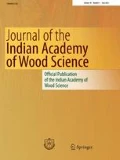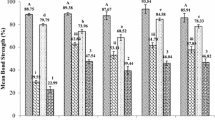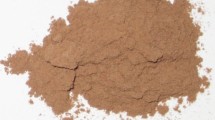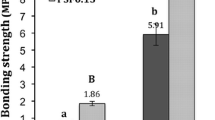Abstract
Expensive adhesives and preservative-chemicals pose challenges to the wood composite industry. Adhesive-extenders reduce cost and enhance ply-joint bonding strength. Urea Formaldehyde (UF) extender was substituted with Milicia excelsa sawdust to formulate five extender-combinations: A (no sawdust), B (100% cassava flour); C (25% cassava flour, 75% sawdust); D (75% cassava flour, 25% sawdust); E (50% cassava flour, 50% sawdust) and F or control (100% cassava flour with 10 g Fossect 88 insecticide). Each glue-mixture contained 3 kg UF (primary resin), hardener (0.6 kg) and water (4.5 l). Ceiba pentandra ply-joint bond strength was subjected to knife-test under dry and cold/moist conditions. Glue-line durability was determined through outdoor exposure. Viscosities for the formulations ranged between 2600cps (for C) to 265cps (for B and F). C had the fastest spreadability(231.67 g/m2) and F the least (188.33 g/m2). Bond strength for D dry-pressed plies (88.750%)] was greatest and E’s (72.083%) the weakest. Bonds weakened under moist conditions; however, C plies’ (73.33%) remained strongest and F’s (67.083%) the weakest. C plies degraded most outdoors (mass loss: 54.434%); F (13.89%) and E (42.964%) performed well. Normal C. pentandra boards lost 28.975%. Visual durability rating followed similar pattern. Appropriately formulated, sawdust from other durable hardwoods has utilization potential as glue/adhesive-extender and would serve as durable in-line treatment for chemical protection of wood composites alongside conventional preservative-chemical in glue mixtures. These need be explored by the wood and other related industries to enhance timber recovery, efficient total utilization and ensure eco-friendliness.




Similar content being viewed by others
References
Anonymous (2010) Evaluation of forestry residue-source oil-tea cake as an extender for phenol-formaldehyde plywood adhesive. http://goliath.ecext.com/coms2/go019915113152/Evaluation-of-forestry-residue-source. Accessed 23 Sept 2011
Anonymous (2011) Wettability of hybrid poplar veneers with cold plasma treatments in relation to drying conditions. http://www.tandfonline.com. Accessed 29 April 2012)
Antwi-Boasiako C, Damoah A (2010) Investigation of synergestic effects of extracts from Erythrophleum suaveolens, Azadirachta indica, and Chromolaena odorata on the Durability of Antiaris toxicaria. Elsevier International Biodeterioration and Biodegradation, pp 97–103
ASTM D 1102-56 (1978) Standard for determining ash content of materials
ASTM D1200-10 (2014) Standard test method for viscosity by Ford Viscosity Cup. Book of Standards Volume: 06.01
ASTM D4442-16 (2016) Standard test methods for direct moisture content measurement of wood and wood-based materials. ASTM International, West Conshohocken, PA. http://www.astm.org. Accessed on 01 Jan 2016
ASTM D2854-83 (2004) Standard for determining apparent density of materials
Barnes HM, Kirkpatrick JW (2005) Biocide treatments for composite panels. In: Tichy R, Yadama V (eds) Proceedings 39th international wood composites symposium, Washington State University, April 5–7, 2005, Pullman, WA, pp 225–231
BASF-The Chemical Company (2006) Glues and resins for the woodworking industry, technical information TI/E-CAL015e October (ARK), pp 2–13
Berg CC (1982) The reinstatement of the genus Milicia Sim (Moraceae). Bulletin du Jardin Botanique National de Belgique 52(1–2):225–229
Derkyi NSA, Darkwa NA, Yartey JD (2008) Effect of cassava flour as urea formaldehyde adhesive extender on the bonding strength of plywood. Ghana J For 23(24):25
Dunky M (2003) Adhesives in wood industry. In: Pizzi A, Mittal K (eds) Handbook of adhesive technology: 2nd ed., Revised and expanded. Chapter 47, 70 pp., Marcel & Dekker Inc., New York, USA
Dyer SA (2001) Survey of Instrumentation and Measurement. Wiley-Interscience, New York, p 721
EN 252 (1990) Field test method for determining the relative protective effectiveness of a wood preservative in ground contact. Published as BS 72782, British Standards Institute, London
EN 314-1 (1993) Plywood bonding quality test methods. Part 1: test methods (1993). BS/EN 314-1
Frihart CR (2005) Wood adhesion and adhesives. In: Rowell RM (ed) Handbook of wood chemistry and wood composites. CRC Press, USA, pp 216–272
Gardner DJ, Tascioglu C, Wålinder ME (2003) Wood composite protection. In: Goodell B, Nicholas DD, Schultz TP (eds) Wood deterioration and preservation: advances in our changing world. American Chemical Society, Washington DC, pp 399–419
Geng XL, Deng J, Zhang SY (2007) Paper mill sludge as a component of wood adhesive formulation. Holzforschung 61(6):688–692
Gillespie RH (1965) Accelerated aging of adhesives in plywood-type joint. For Prod J 15(9):369–378
Goktas O, Mammadov R, Duru EM, Ozen E, Colak MA, Yilmaz F (2007) Introduction and evaluation of the wood preservative potentials of the poisonous Sternbergia candidum extracts. Afr J Biotechnol 6(8):982–986
Hartley J, Marchant J (1995) Methods of determining the moisture content of wood. Technical paper No. 41. Research Division State Forests of New South Wales, Sydney. 54 pp
Haygreen JG, Bowyer JL (1996) Forest products and wood science, 3rd edn. Iowa State University Press, Ames
Hojilla-Evangelista MP (2010) Adhesion properties of plywood glue containing soybean meal as an extender. J Am Oil Chem Soc 87(9):1047–1052
Hojilla-Evangelistica MP (2009) Corn: the latest glue ingredient. http://www.nps.ars.usda.gov. Accessed 8 Mar 2012
Ibach RE (1999) Wood preservation. In: Wood handbook: wood as an engineering material. general technical report FPL—GTR-113. Forest Products Laboratory, Forest Service, U.S. Department of Agriculture, Madison, Wisconsin
Indian Plywood Industries Research and Training Institute [IPIRTI] (2011) Adhesives. http://www.ipirti.goc.in/Contact.html. Accessed 23 Dec 2011
Irvine FR (1961) Woody plants of ghana with special reference to their uses. Oxford University Press, London, pp 91, 427–428
Kannangara DN (2011) Natural Preservatives in Timber Preservation. http://www.NEEMPR/NaturalpreservativesintimberpreservationAppliedScienceBlog.htm. Accessed 7 Sept 2011
Kartal SN, Green F (2003) Decay and termite resistance of medium density fiberboard (MDF) made from Different wood species. Int Biodeterior Biodegrad 5(1):29–35
Kleinert M, Barth T (2008) Phenols from Lignin. Chem Eng Technol 31(5):736–745
Kollmann FFP, Côté AJ (1984) Principles of wood science and technology, vol 2. Springer-Verlag, Berlin
Laks P (2002) Biodegradation susceptibility of engineering wood products, School of Forestry and Wood Products. Michigan Tech, 1–33
Lee S (2003) Fundamental properties of borate-modified oriented strandboard from southern wood species. Ph.D. Dissertation, School of Renewable Natural Resources, Louisiana State University, p 158
Mohandos KK (1992) Adhesive for Bonding Plywood. Wood News 2, Vol. 2 & 3, p 55
Nakarai Y, Watanabe T (1962) Wood adhesives and bond strength. Wood Ind 17:464–468
Neusser H, Schall W (1972) Study on some promising possibilities of plywood improvement. 1. Glueing with aminoplasts. Holzforsch Holzverwert 24:108–116
Onuorah EO (2000) Relative efficacy of heartwood extracts and proprietary wood preservatives as wood protectancts. J For Res 13(3):183–190
Pizzi A (1983) Wood adhesives: chemistry and technology; Dekker M (Ed), New York, 1983, pp 177–247
Pizzi A (1990) A molecular mechanics approach to the adhesion of urea-formaldehyde resins to cellulose. Part 1. Crystalline cellulose I. J Adhes Sci Technol 4(1):573–588
Rengi D (2011) What is urea formaldehyde? Ed-William C http://www.wisegeek.com/faq.htm. Accessed 23 Dec 2011
Rice JT (1965) Effect of urea-formaldehyde resin viscosity on plywood wood bond durability. For Prod J 15(3):107–112
Roth RA (2014) Nutrition and diet therapy, 11th edn. Delmar Cengage Learning, USA, p 587
Selbo ML (1975) Adhesive bonding of wood. Tech Bull 1512. Washington, DC: U.S. Department of Agriculture, Forest Service
Singh M (2015) Durability: a systematic study of water and the adhesive bond; Webinar Live. Adhesive and Sealant Council. Securing the future. Webinar Event-11/18/2015. © 2012 The Adhesive and Sealant Council|7101 Wisconsin Avenue, Suite 990|Bethesda, Maryland 20814
Smith WR, Wu Q (2005) Durability improvement for structural wood composites through chemical treatments. For Prod J 55(2):8–17
Thompson WS (1962) Effect of preservative salts on the gluing of treated sweetgum veneer. For Prod J 12(9):431–436
Tuffour I (2006) Utilization of Ceiba pentandra Sand Dust as Extender and Filler in Plywood Adhesive. M.Sc. Thesis, Kwame Nkrumah University of Science and Technology, Kumasi, Ghana
Vick CB (1999) Adhesive bonding of wood materials. In: Wood Handbook: Wood as an Engineering Material. U.S. Department of Agriculture, Forest Service, Forest Products Laboratory, Madison, WI, Chap. 9
Weimer PJ, Koegel RG, Lorenz LF, Frihart CR, Kenealy WR (2005) Wood Adhesives prepared from Lucerne Fiber Fermentation Residues of Ruminococcus albus and Clostridium thermocellum. Appl Microbiol Biotechnol 66(6):635–640
Woodsolutions (2011) Plywood. http://www.woodsolutions.com.au. Accessed 19 Sept 2011
Yalinkilic MK, Imamura Y, Takahashi M, Kalaycioglu H, Nemli G, Demirci Z, Ozdemir T (1998) Biological, physical and mechanical properties of particle board manufactured from waste tea leaves. Int Biodeterior Biodegrad 41(1):75–84
Yamaguchi H, Higuchi M, Sakata I (1989) Durability of urea-formaldehyde resin adhesive. Effect of pH of the adhesive resin layer. J Jpn Wood Res Soc 35(9):801–806
Acknowledgments
We thank the Management and Staff of Samartex Timber and Plywood Company Ltd. (Samreboi, Ghana) who offered their well-designed Plymill for the investigation. We further acknowledge the technical support from the Staff of the Chemistry and Wood Workshop Laboratories (Department of Wood Science and Technology) and the Faculty of Renewable Natural Resources Experimental Plot, KNUST (Kumasi-Ghana). The statistical advice provided by Miss Agnes Ankoma Danso (Biometrician, Crops Research Institute of Ghana, Council for Scientific and Industrial Research [CSIR], Fumesua-Kumasi) is much appreciated.
Author information
Authors and Affiliations
Corresponding author
Rights and permissions
About this article
Cite this article
Antwi-Boasiako, C., Abam, S. Milicia excelsa (Welw.) C. C. Berg sawdust as glue-extender in urea formaldehyde-adhesive in enhancing Ceiba pentandra (L.) Gaertn. veneer joint bonding strength. J Indian Acad Wood Sci 14, 60–69 (2017). https://doi.org/10.1007/s13196-017-0188-8
Received:
Accepted:
Published:
Issue Date:
DOI: https://doi.org/10.1007/s13196-017-0188-8




